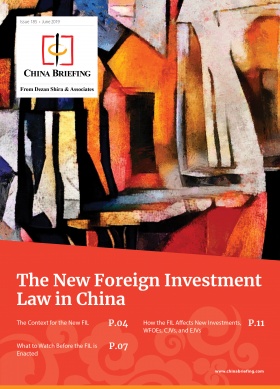Investment Opportunities in China’s Healthcare Sector After COVID-19
The coronavirus (COVID-19) outbreak has revealed both the strengths and weaknesses of China’s healthcare system.
On the one hand, the Chinese government was able to massively increase the country’s short-term care capacity, providing emergency hospital beds and conducting widespread testing. On the other hand, the outbreak exposed wide disparities in the quality of care between hospitals across regions.
COVID-19 and the lessons learned from managing the outbreak could profoundly shape the direction of China’s healthcare market, which had been projected to be worth RMB 16 trillion (US$2.3 trillion) by 2030.
Here, we look at what may be coming to China’s healthcare sector, once the coronavirus is overcome and what opportunities it realistically presents foreign investors.
Push for higher healthcare spending is inevitable
The coronavirus outbreak is likely to lead to a surge in investment in China’s healthcare system.
China was already poised for substantial increases in healthcare spending due to economic growth and a rapidly aging population in need of greater health services.
China’s population is aging at a historic rate, with the proportion of elderly people 65 years or older projected to double from 10 percent of the population in 2017 to 20 percent by 2037. According to the United Nations, 27.5 percent of China’s population will be 65 years or older by 2050, compared to just 9.5 percent in 2015.
While higher healthcare spending was already expected as a long-term trend, the coronavirus may inspire structural upgrades and reforms to China’s healthcare system.
After the SARS outbreak in 2003, the Chinese government invested in areas where the healthcare system’s deficiencies were exposed. This included promoting greater transparency, improving surveillance of infectious diseases, investing in public education, and creating disease reporting systems and disease control centers.
Similar initiatives are likely to take place in the months and years after the coronavirus is contained, as authorities look to resolve deficiencies.
Establishing consistency in the capabilities of different hospitals
The coronavirus outbreak showed that there is not only substantial variation in the capabilities of hospitals across regions, but also within single cities.
In China, large and better-resourced hospitals are responsible for a disproportionate share of service delivery. Just eight percent of hospitals care for over 50 percent of all patients.
According to the consultancy Bain & Company, of 203 smaller community hospitals in Wuhan – the epicenter of the outbreak – only 10 of them were prepared to admit and treat patients exhibiting coronavirus symptoms.
Tertiary education, talent incentives, and medical infrastructure
China has a relatively low ratio of doctors to people, with 1.8 physicians per 1,000 people, compared to 2.4 in the US and Japan. The problem is even more acute in relation to general practitioners and specialists. Per the World Health Organization (WHO), only about half of China’s doctors have a bachelor’s degree, showing that there is a substantial skills deficit in the sector.
Solving these deficiencies will require greater investments in tertiary education across the country, beyond China’s prestigious top schools. Moreover, public hospitals offer low wages, long hours, and stressful work conditions. Improvements in these areas would incentivize more talent to join the healthcare sector.
China’s medical infrastructure is also in need of additional capacity, both in terms of physical space and access to technology. Even in normal times, major Chinese hospitals are often nearly at full capacity. At the end of 2018, the occupancy rate of Wuhan’s hospital beds was at 94 percent, per the city’s health commission.
Digitization insights from China’s management of the outbreak
A notable feature of China’s response to the coronavirus has been the widespread use of mobile apps for medical information and services. Compared to the SARS outbreak, when citizens relied on official channels to receive information and were given inconsistent messaging, during the coronavirus outbreak – citizens have been able to keep up to date with developments in real time.
Expanding functionality of social media apps
Social media super apps like WeChat and Weibo emerged both as disseminators of public health information and as feedback mechanisms for users through official accounts, key opinion leaders, and standard user interaction.
Similarly, the Chinese tech company Baidu augmented its map app to highlight high-risk areas where infections would be more likely.
The widespread use of social media and other apps for medical information demonstrates the importance of stakeholders of all kinds to engage with new media during crises rather than only traditional channels.
Healthcare apps
More ground-breaking, however, was the unprecedented adoption of digital health services.
Healthcare apps like Ping An Good Doctor, Ding Xiang Yuan, and Chunyu Doctor saw their user bases grow dramatically in response to the coronavirus. Ping An Good Doctor, for instance, reported a 900 percent increase in new users from December 2019 to January 2020.
Apps such as Ping An Good Doctor provided services like online and telephone consultations to users seeking health information and worried about their symptoms. Users can also reserve in-person medical appointments, purchase medicine and healthcare products, and receive discounts on the app.
More controversially, the local government of Hangzhou created a mobile health app, which is hosted by platforms such as Alipay and WeChat. The app designates users’ health stats as either green, yellow, or red to provide information on whether users should quarantine themselves and may also share the information with government authorities.
Digitized health services are still at a relatively early stage of development, but represent one of the largest potential areas of growth in the healthcare sector. With the coming adoption of 5G and the Internet of Things (IoT), support for digitized healthcare and telemedicine will likely be a point of emphasis for government planners in the coming years.
Technology
In addition to digital apps, the Chinese government and private firms are using hard technology in innovative ways to combat the coronavirus.
Businesses and local governments have deployed drones to spray disinfectants, transport medical samples, conduct tests, and deliver consumer goods. For example, Shenzhen’s MicroMultiCopter used its drones to carry medical samples and to conduct thermal imaging tests. After coronavirus containment measures interrupted ferry services that provided consumer goods to the island community of Anxin, the e-commerce giant JD sent drones to deliver goods instead.
Some Chinese hospitals are also trialing the use of robots to assist medical workers. Wuhan’s Hongshan Sports Center, a so-called Smart Field Hospital, is using robots and IoT-enabled technology to monitor patients’ temperatures, vital signs, heart rates, and other indicators. Robots are also being used in hospitals and hotels to deliver food and medicine, thereby reducing human interaction and the risk of the virus spreading.
China’s healthcare sector a priority investment area this decade
Facing a rapidly aging population and citizens demanding higher quality services, China’s healthcare sector was already positioned to become an area of priority government attention in the coming decade.
The outbreak of the coronavirus, however, has added urgency. While the outbreak highlighted the multitude of China’s technology achievements and systemic strengths, it also exposed numerous gaps in delivery of care.
As China strives to improve its healthcare capacity, there will be substantial opportunities for producers of medical devices, hygiene products, and other healthcare amenities. Opportunities will not be limited to traditional medical companies, but also educational institutions and digital disruptors.
The coronavirus has still not been eradicated and is expected to return next winter. This means immediate service delivery will remain the Chinese government’s priority in the short-term. Once the current crisis is overcome, however, there will likely be an accelerated process of identifying which gaps to invest in the Chinese healthcare system.
Foreign investors should monitor indications like the Foreign Investment Catalogue and Negative List for sector openings and relaxations.
Related Reading
 New Business Opportunities Emerging in China Under COVID-19 Outbreak
New Business Opportunities Emerging in China Under COVID-19 Outbreak
 China’s Tax Concessions for Elderly Care, Childcare, and Domestic Services Industries
China’s Tax Concessions for Elderly Care, Childcare, and Domestic Services Industries
 China’s Support Policies for Businesses Under COVID-19: A Comprehensive List
China’s Support Policies for Businesses Under COVID-19: A Comprehensive List
About Us
China Briefing is written and produced by Dezan Shira & Associates. The practice assists foreign investors into China and has done since 1992 through offices in Beijing, Tianjin, Dalian, Qingdao, Shanghai, Hangzhou, Ningbo, Suzhou, Guangzhou, Dongguan, Zhongshan, Shenzhen, and Hong Kong. Please contact the firm for assistance in China at china@dezshira.com.
We also maintain offices assisting foreign investors in Vietnam, Indonesia, Singapore, The Philippines, Malaysia, and Thailand in addition to our practices in India and Russia and our trade research facilities along the Belt & Road Initiative.
- Previous Article China After COVID-19: How Foreign Companies Can Leverage Key IT Solutions
- Next Article China’s Social Credit System: COVID-19 Triggers Some Exemptions, Obligations for Businesses







